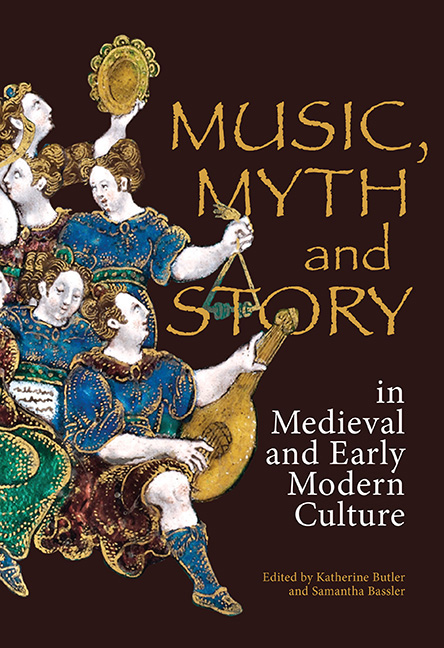Book contents
- Frontmatter
- Contents
- List of Illustrations
- List of Contributors
- Editors’ Note
- Introduction
- I MYTH IN MEDIEVAL MUSIC THEORY AND PHILOSOPHY
- II ICONOLOGIES OF MUSIC AND MYTH
- III MYTHS IN RENAISSANCE PHILOSOPHIES OF MUSIC
- IV MYTH AND MUSICAL PRACTICE
- V NARRATIVES OF PERFORMANCE
- 10 Ophelia's Mad Songs and Performing Story in Early Modern England
- 11 Dangerous Beauty: Stories of Singing Women in Early Modern Italy
- VI MYTH AND MUSIC AS FORMS OF KNOWLEDGE
- VII RE-IMAGINING MYTHS AND STORIES FOR THE STAGE
- Bibliography
- Index
- Studies in Medieval and Renaissance Music
11 - Dangerous Beauty: Stories of Singing Women in Early Modern Italy
from V - NARRATIVES OF PERFORMANCE
Published online by Cambridge University Press: 24 October 2019
- Frontmatter
- Contents
- List of Illustrations
- List of Contributors
- Editors’ Note
- Introduction
- I MYTH IN MEDIEVAL MUSIC THEORY AND PHILOSOPHY
- II ICONOLOGIES OF MUSIC AND MYTH
- III MYTHS IN RENAISSANCE PHILOSOPHIES OF MUSIC
- IV MYTH AND MUSICAL PRACTICE
- V NARRATIVES OF PERFORMANCE
- 10 Ophelia's Mad Songs and Performing Story in Early Modern England
- 11 Dangerous Beauty: Stories of Singing Women in Early Modern Italy
- VI MYTH AND MUSIC AS FORMS OF KNOWLEDGE
- VII RE-IMAGINING MYTHS AND STORIES FOR THE STAGE
- Bibliography
- Index
- Studies in Medieval and Renaissance Music
Summary
ONE of the most brutal tales in Greek mythology tells of the dangers of women's voices. This is the story of the nightingale. As related in Ovid's Metamorphoses, the virgin Philomela is violated by Tereus, husband of her sister Procne. Maddened and shamed, Philomela threatens to reveal her ‘unspeakable bedding’ to the world, upon which Tereus excises her tongue to prevent exposure. Despite being mute, however, Philomela regains her voice by weaving a message in a tapestry sent to Procne, who frees her. The two sisters then enact a bloodthirsty revenge on Tereus – tricking him into cannibalising his own son – before all three characters are transformed into birds. Procne turns into a swallow, while Philomela becomes the nightingale, whose powerful voice could not be silenced through the removal of her tongue. In her avian form, she sings laments and songs to welcome the spring.
During the early modern period, responses to the myth of Philomela often connected the bird's beautiful song and violence. As an icon of music this myth-encrusted bird revealed male suspicions regarding sonic beauty and femininity, closely related phenomena in the Renaissance epistemology. For example, the links between music, women and malevolence are made explicit in Cesare Ripa's Iconologia (1593), which was reprinted throughout the seventeenth and eighteenth centuries. In this popular book of emblems, the nightingale is an attribute of two iconographic females: Music, who is described as ‘a beautiful young woman’, and the ugly old hag who represents Cruelty. Meanwhile, in Italian poetic re-appropriations of the myth of Philomela, male writers emphasised feminine culpability while doing with their pens the same thing that Tereus achieved with his knife: even if only within the stories they told, they muted female self-expression.
In much pastoral poetry, the songs of the newly created birds either recede into the background by becoming common springtime sounds, or are silenced altogether. For example, in Petrarch's ‘Zephiro torna’ (from the Canzoniere), the musical plaints of the nightingale and swallow are among the many poetic devices used to evoke the pastoral landscape:
Zephiro torna, e ‘l bel tempo rimena,
e i fiori et l'erbe, sua dolce famiglia,
e garrir Progne et pianger Philomena,
et primavera candida et vermiglia.
- Type
- Chapter
- Information
- Music, Myth and Story in Medieval and Early Modern Culture , pp. 187 - 204Publisher: Boydell & BrewerPrint publication year: 2019

